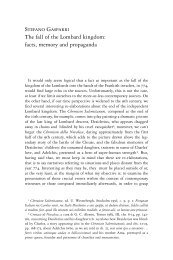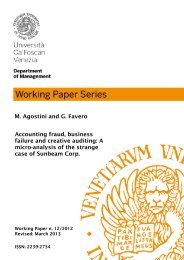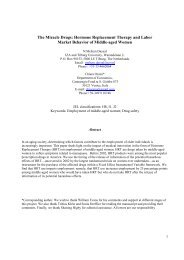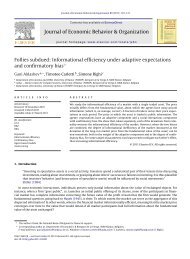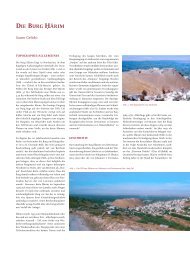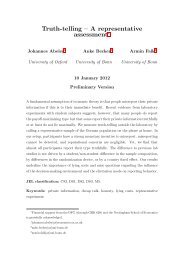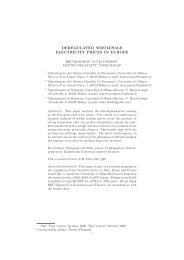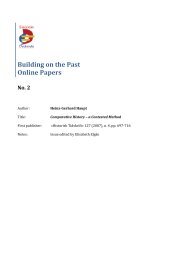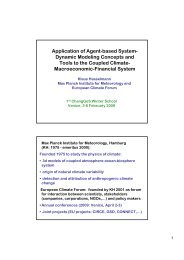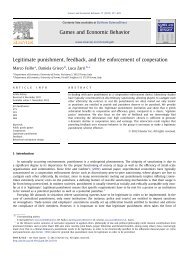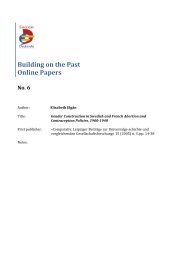The pilot area of Auronzo di Cadore (Belluno) - Università Ca
The pilot area of Auronzo di Cadore (Belluno) - Università Ca
The pilot area of Auronzo di Cadore (Belluno) - Università Ca
You also want an ePaper? Increase the reach of your titles
YUMPU automatically turns print PDFs into web optimized ePapers that Google loves.
Box 3<br />
Participatory development<br />
<strong>of</strong> shared scenarios in brief<br />
4 / Phase 2 / Problem Analysis<br />
and Creative ve System Modelling<br />
<strong>The</strong> problems faced by planners and managers are complex and their<br />
drivers interwoven. It is necessary to identify the most relevant aspects,<br />
by focusing on which the major changes can be attained. Different stakeholders<br />
hold <strong>di</strong>fferent perceptions and beliefs about what are the causes<br />
<strong>of</strong> the problem or how it should be tackled. Different techniques<br />
have been developed to surface tacit knowledge and deeply held beliefs,<br />
inclu<strong>di</strong>ng conflict assessment, problem structuring methods, and<br />
<strong>di</strong>scourse analysis.<br />
Main outputs / (1) A list <strong>of</strong> most relevant drivers governing the perception<br />
<strong>of</strong> the problem at hand (2) A preliminary list <strong>of</strong> possible solutions<br />
can<strong>di</strong>date to be assessed (3) A set <strong>of</strong> scenarios regar<strong>di</strong>ng the future development<br />
<strong>of</strong> the main drivers and cause-effect relations (4) An extensive<br />
list <strong>of</strong> in<strong>di</strong>cators against which the performance <strong>of</strong> the (5) <strong>The</strong> shared<br />
mental maps elicited at the CSM workshop will be the underlying modelling<br />
framework for tailoring the ClimAlpTour e-tool to the specific<br />
needs (6) <strong>The</strong> qualitative and/or quantitative in<strong>di</strong>cators to be used in the<br />
choice phase with the DSS ClimAlpTour e-tool (7) A quantitative assessment<br />
<strong>of</strong> these in<strong>di</strong>cators, in ad<strong>di</strong>tion to their identification<br />
In this phase the problem <strong>of</strong> winter tourism development in <strong>Auronzo</strong> <strong>di</strong><br />
<strong><strong>Ca</strong>dore</strong> was scrutinised from various perspectives and viewpoints. <strong>The</strong><br />
key actors identified in the first phase contributed to the development <strong>of</strong> a<br />
shared vision <strong>of</strong> the human-environmental system. <strong>The</strong> exploration <strong>of</strong> the<br />
problem includes analyses <strong>of</strong> legal and institutional frameworks, as well as<br />
the economy on various spatial levels and the state <strong>of</strong> environment. Future<br />
development <strong>of</strong> main drivers and pressures are simulated using models<br />
under alternative scenarios.<br />
Moreover, since a shared model <strong>of</strong> reality is needed for the correct evaluation<br />
<strong>of</strong> options, through the application <strong>of</strong> Creative System Modelling (CSM)<br />
techniques, creative thinking and cognitive mapping, it was possible to facilitate<br />
the process <strong>of</strong> participatory modelling and elicitation <strong>of</strong> knowledge<br />
and preferences from actors, thus buil<strong>di</strong>ng a common understan<strong>di</strong>ng <strong>of</strong><br />
the problem. Moreover, CSM also provides a scientifically-sound basis for<br />
the application <strong>of</strong> effective decision support systems (DSS), such as the<br />
ClimAlpTour e-tool.<br />
28




